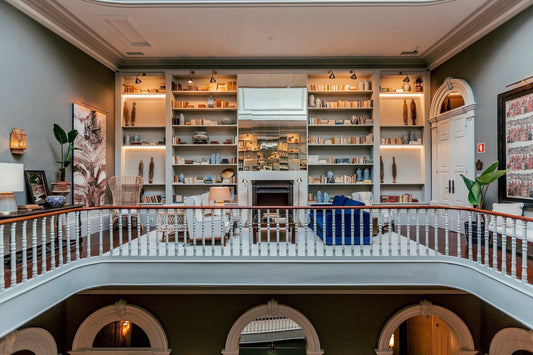Breathing with the City: Discovering Centro de Arte Moderna Lisbon
Text and Photos by Kerol Izwan.
The last time I was in Lisbon, the museum gardens were closed, and I remember feeling intrigued about what was taking shape behind those gates. Too bad on that trip I didn’t have the chance to see what was being built. I did, however, make my usual stop at Under the Cover, my favourite magazine shop opposite the gardens — a handsome space where Musotrees copies can also be found. On my most recent visit, I finally witnessed the transformation firsthand.

The new Centro de Arte Moderna (CAM) at the Gulbenkian Museum is a sight that merges both modern and traditional gestures. The sculptural roofline, clad in Portuguese white tiles, caught me instantly — almost appearing to shift with the wind under the Lisbon sun. From my perspective, it was alive, in motion, shaping the skyline with a gentle rhythm. The gardens, beautifully designed by Vladimir Djurovic, were filled with people resting, chatting and enjoying the bright afternoon. It felt as though time had paused, yet the surroundings breathed for us. This is an oasis within the city, a sanctuary that balances architecture, art and nature.


Behind this transformation is the celebrated Japanese architect Kengo Kuma, known globally for his ability to dissolve the boundaries between built space and landscape. At CAM, his approach unfolds in subtle ways. The architecture is measured, calm and deliberate, offering a frame for experience rather than a statement of dominance. Light filters gently across the interiors, materials echo natural textures, and openings reveal glimpses of the gardens. The building seems less like a container and more like a living partner to the art inside, guiding visitors into a state of quiet reflection.
What makes CAM particularly distinctive is the seamless relationship between architecture and landscape. Djurovic’s gardens are not ornamental additions, but essential parts of the design. Water, pathways and planted terraces extend the museum outward, softening transitions and slowing the visitor’s pace. Stepping out of a gallery is not an exit, but a continuation — an encounter with nature that adds depth to the way art is experienced.

 This holistic vision challenges the idea of museums as neutral white boxes. At CAM, artworks are never in isolation; they are viewed in relation to shifting daylight, to the presence of water, to the movement of leaves beyond the windows. The architecture and landscape quietly shape the visitor’s rhythm, encouraging pause, attention and discovery.
This holistic vision challenges the idea of museums as neutral white boxes. At CAM, artworks are never in isolation; they are viewed in relation to shifting daylight, to the presence of water, to the movement of leaves beyond the windows. The architecture and landscape quietly shape the visitor’s rhythm, encouraging pause, attention and discovery.
The reopening of CAM is also significant for Lisbon as a whole. Long known for its historic charm, the city is steadily gaining recognition for contemporary cultural projects that enrich its identity. The Gulbenkian Museum has always been a cornerstone of Lisbon’s cultural life, and this renewal signals its commitment to remain vital for future generations. In aligning with Kuma and Djurovic, it demonstrates how institutions can evolve while staying rooted in sensitivity and quality.
 Spending the afternoon at CAM, I felt the city shift around me. Unlike the busy streets of the old town, here was a space of balance — part museum, part park, part retreat. I lingered among the gardens, moved slowly through the galleries and sat beneath the sculptural roofline that seemed to ripple against the sky. It was not only about seeing art, but about experiencing Lisbon in a quieter, more present way. In that moment, CAM was not just a cultural landmark. It was a place to pause, breathe and belong.
Spending the afternoon at CAM, I felt the city shift around me. Unlike the busy streets of the old town, here was a space of balance — part museum, part park, part retreat. I lingered among the gardens, moved slowly through the galleries and sat beneath the sculptural roofline that seemed to ripple against the sky. It was not only about seeing art, but about experiencing Lisbon in a quieter, more present way. In that moment, CAM was not just a cultural landmark. It was a place to pause, breathe and belong.
/



